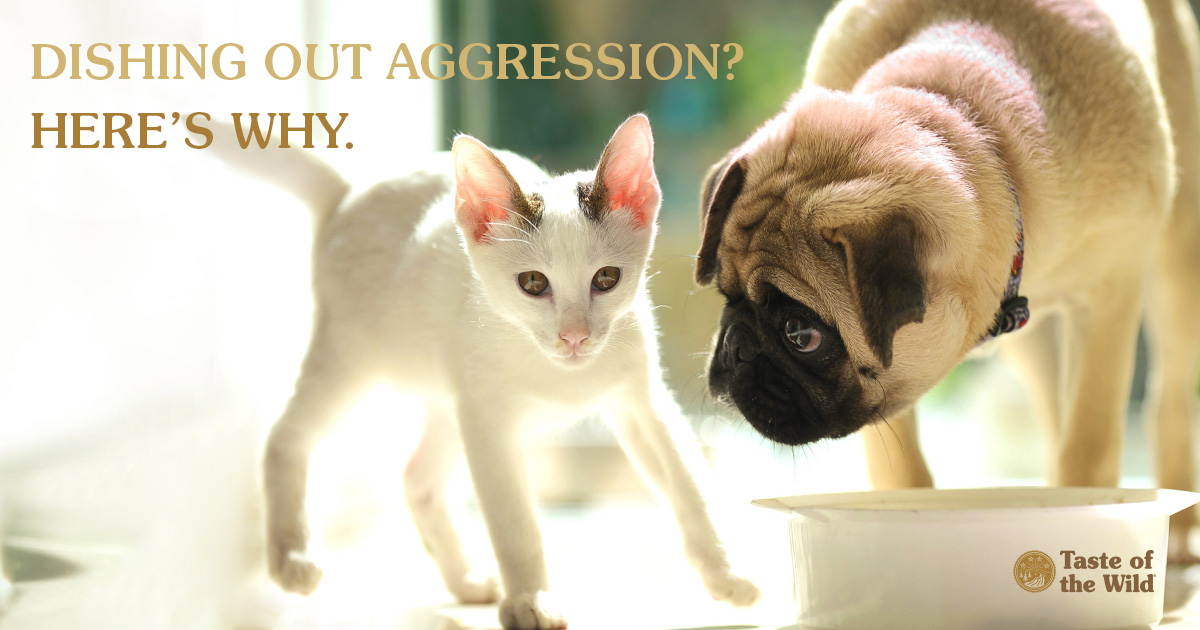
Almost every dog relishes the food dish. Many dogs will show their enthusiasm by spinning in circles or dancing on their hind legs when the bowl makes an appearance. But once the bowl is on the floor, some dogs can become downright territorial, growling, lunging and even biting if anyone approaches their bowl.
It’s mine, mine, mine
Dogs with this “food-guarding” behavior generally become protective or aggressive to maintain possession of foods or treats. The aggression can be directed at other pets and even people. Typically, a dog with food-guarding tendencies may stiffen, raise its hackles or growl when another dog or person approaches the food. It may run into another room with a treat or it may defend its territory by snapping or even biting.
Food guarding is a subset of resource guarding, in which dogs display this behavior around toys, bones, or other “high-value” items. It is a normal behavior in the wild where wolves, coyotes and other canids sometimes compete for limited food. But in a regular household — especially one with small children — this resource guarding can be dangerous.
What causes food guarding?
The behavior is most likely a combination of genetics, early experiences during puppyhood and learned behaviors. Some surmise that puppies develop this tendency if the entire litter was fed out of one bowl and puppies had to compete for food.
However, some dogs may growl if they have medical conditions that cause pain when at the food bowl, such as a broken tooth or arthritis. Other medical conditions that increase their appetite or thirst may cause dogs to be aggressive around their bowls, too. That’s why it’s important to ask your veterinarian to rule out medical causes first, because resolution of those conditions may in turn eliminate the food guarding.
What not to do
If your dog shows signs of food aggression, punishment or grabbing the food bowl away aren’t the answer. If anything, those actions may escalate your dog’s anxiety, fear and aggression. The dog may respond by guarding other items in an effort to maintain control.
At the same time, retreating when your dog shows aggression may also reinforce the behavior. If your dog shows severe signs of aggression, for your safety, consider working with a veterinary behavior specialist, a certified applied animal behaviorist or professional trainer with experience in food aggression.
Changing food-guarding behaviors
Always start with your veterinarian to make sure there aren’t any underlying health conditions contributing to the issue.
If the food guarding is relatively mild, it may suffice to put the dog in a separate room, away from other pets or people, while it eats food, treats or plays with a high-value toy. If the dog is consistently fed in this non-threatening environment, it may help reduce the motivation to become aggressive.
You can begin teaching your dog to be calm around the food bowl with desensitization and counter-conditioning, but this should only be done if you are confident you’re not in danger. The goal is to teach your dog that it can be a positive experience when you approach the bowl because you may offer an even more delectable treat.
Start by standing a few feet away from your dog during meal time, talk to your dog in a conversational tone and periodically toss treats your dog adores near the bowl, such as hot dog slices or cheese. Do this for every meal for the first week.
If your dog remains calm, take a step toward the bowl, drop the treat and take a step back. Continue doing this for another week, as long as your dog remains calm. Gradually move closer to the bowl and drop a treat in the bowl while your dog is eating. If your dog tolerates this, gradually move close enough to offer a treat from your hand while the dog is eating.
As long as your dog doesn’t seem anxious, you can gradually move to touching the bowl with one hand while offering a treat with the other hand, then gradually lifting the bowl while offering a treat.
In severe cases, your veterinarian may recommend medications to help reduce your dog’s anxiety level. Even so, food guarding may not be completely cured, but it can be managed. And when your dog is less anxious around the food bowl, you can be, too.
The information in this blog has been developed with our veterinarian and is designed to help educate pet parents. If you have questions or concerns about your pet's health or nutrition, please talk with your veterinarian.
